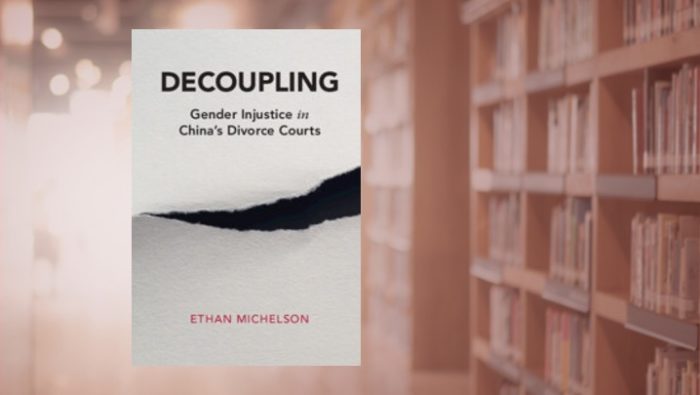
Marital and Institutional Decoupling in China

‘I decided … to use the legal arsenal to protect my rights’, said a domestic violence victim in one of the [tens of thousands] of divorce judgments which form the empirical basis for Ethan Michelson’s superb Decoupling: Gender Injustice in China’s Divorce Courts. On paper, the legal arsenal for victims of marital abuse in China is extensive. In practice, when litigants turn to the courts to decouple, they face an institutional decoupling: a disconnect between China’s purported adherence to international norms of gender equality, and the ‘street-level bureaucratic’ norms and forces actually at play in divorce courts.
For the litigant quoted above, turning to the law exposed her to further danger. She was threatened by her husband to withdraw her first divorce petition; she did so, and his violence intensified. Though she gathered photographs of her extensive injuries, and testimony from eyewitnesses, her second petition was denied because the judge noted the ‘definite marital foundation of both sides thanks to…20 years of marriage and three children’ (p.231), dismissing the evidence presented as insufficient to corroborate her claims.
Michelson’s research is epic in scale and devastating in terms of the picture it paints. The analysis is based on almost 150,000 divorce trials; the data-set comprises cases from 2009-2016 from all 252 basic-level courts in Henan and Zhejiang. By blending big-data computational social science and narrative case analysis, Michelson meticulously unpacks the causes of the “divorce twofer” – the institutionalized practice of routinely denying first-time divorce petitions. The consequence of the “divorce twofer” is that abusive husbands have a trump card over their victims by withholding their consent to a divorce. In doing so, abused women face an impossible dilemma: to stay, enduring further violence and risking death; to flee, leaving behind children, family, and financial security; or to try to navigate the legal system – one that purports to protect them but, in practice, violates global legal norms pertaining to freedom of divorce and protection against domestic violence.
Methodologically, Michelson’s work demonstrates the unprecedented research opportunities presented by the sheer volume of online court decisions now available in China. By taking a “big data” computational approach, and setting out his quantitative methods in scrupulous detail, this study points to the wealth of insights that can be drawn from the millions of court decisions available on China Judgments Online. His rigorous quantative methods are combined with rich qualitative analysis, based primarily on a collection of 116 illustrative case analyses, with URL links to the full text of every case cited. Throughout, the narrative method is deployed to ensure that the human faces of this big data analysis are kept in sight.
Over the course of its twelve chapters, the book comprehensively and convincingly unpacks both the causes and gendered consequences of the “divorce twofer”. The causes include pressure from heavy judicial caseloads; political ideology emphasising marital preservation; performance evaluation systems; the risk of violence against court personnel; and patriarchal cultural values. In all, these result in judicial disregard for the rights and interests of women seeking to divorce their abusive husbands. The consequences of the twofer are inevitable and grim, and Michelson skilfully uses a variety of empirical methods to focus on the dimension of gender injustice. Quantitative and qualitative methods are used to demonstrate both the prevalence of domestic violence allegations in divorce petitions, and the unimportance of such allegations and considerations to judicial decision-making and legal outcomes.
On the human cost of the “divorce twofer”is the idea of gaslighting on an institutional level. As the book moves from causes to consequences of the divorce twofer, Michelson lets judges and plaintiffs do the talking, using case extracts to illustrate the “seemingly boundless determination” of judges to deny divorce petitions, no matter how violent the marriage in question. These extracts show in disturbing detail how judges routinely ‘discursively transform what plaintiffs understood as intolerable and unlawful abuse … into innocent misunderstandings and mistakes on the part of caring husbands’ (p.261). In doing so, Michelson argues that judges reinforce the gaslighting of domestic violence victims, calling into question their sense of reality. Judges use hackneyed cliches – “we urge you to calm down” – and characterise extreme violence as mere “marital squabbles”. Letters of remorse submitted as proof of ongoing abuse were transformed through perverse judicial logic into evidence of marital commitment and affection, and used to justify first-instance denial. Judges represent victims as irrational, irresponsible, unpatriotic. Abusers are cast as remorseful, redeemable, willing to strengthen the nation by strengthening families. In all, the case analyses show how judges construct an alternate reality in their judgments, while sending victims home to deal with the consequences of all-too-real violence.
As a ‘gap study’, this work demonstrates that the gap between law on the books and the law in action exemplified by the “divorce twofer” is not merely a bug in the system, but a feature of Chinese divorce law. Despite top-down orders and legislation bearing the hallmarks of global gender equality norms, Chinese judges’ application of the law undermines domestic violence victims’ rights. In this way, while global scripts have penetrated the surface level of China’s legal order, they are subverted in practice – ‘sidelined to the point of irrelevance’ (p. 473) – by durable, endogenous local barriers to divorce and domestic violence protection.
In a short review of a book of this magnitude, it is not possible to cover all of its methodological and theoretical contributions but scholars from wide-ranging fields and traditions will find this book of interest, for a variety of academic reasons. At a personal level, all will recognise the urgency of the problems presented. As Michelson notes in his final paragraphs, there are half a million adjudicated divorce decisions a year in China; if two-thirds of those decisions involve women plaintiffs, 40% of them experience domestic violence, and 70% of their petitions are denied [these numbers are based on Michelson’s empirical analysis]. This suggests that tens of thousands of abuse victims who have found the courage to seek divorce are being denied annually, and may therefore continue to endure abuse. Until both upstream and downstream reforms take hold, Chinese women will continue to find their legal arsenal utterly lacking.

